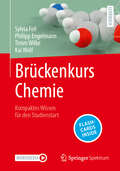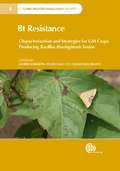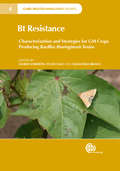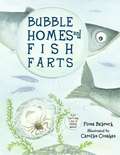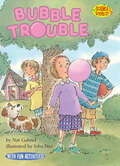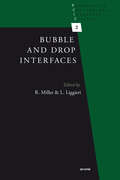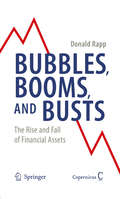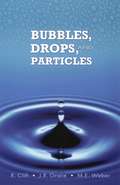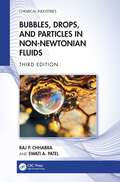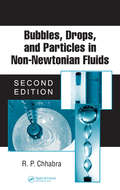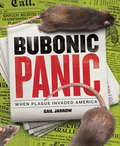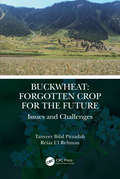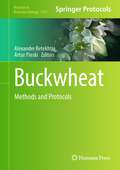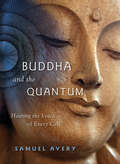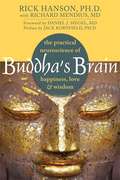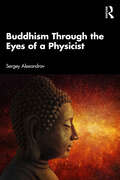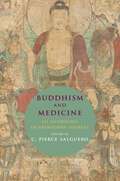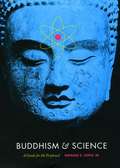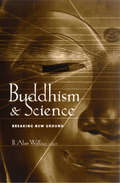- Table View
- List View
Brújula para navegantes emocionales
by Elsa PunsetConocerse a uno mismo permite descubrir las fuentes de nuestra felicidad, nuestra ira y nuestro dolor para poder convivir armoniosa y plenamente con nosotros mismos y con los demás. En el fondo instintivo de nuestro ser, no pensamos, sentimos. Estamos hechos de emociones. A lo largo de los siglos nos habíamos esforzado en encerrarlas en sistemas de vida ordenados y represivos. Ante su dictado solo cabía resignarse o rebelarse. Actualmente vivimos en un mundo que nos abruma con tentaciones y decisiones múltiples y tenemos que decidir en soledad quiénes somos y por qué nos merece la pena vivir. Esta nueva libertad reclama la adquisición de una brújula que nos permita navegar con inteligencia emocional por los cauces imprevisibles de nuestras vidas. Este libro recorre las distintas etapas de maduración emocional y social del ser humano no solo como individuo, sino también en relación a las personas que conforman nuestro entorno: padres, hijos, pareja, compañeros, amigos... En el siglo XXI las emociones, gracias a las puertas que ha abierto la neurociencia, pueden catalogarse, comprenderse e incluso gestionarse: son la llave de nuestro centro neurálgico, llámese cerebro, alma, conciencia o libre alberdrío. La crítica ha dicho...«Uno de los mejores libros de divulgación científica del año.»El Mundo
Brückenkurs Chemie: Kompaktes Wissen für den Studienstart
by Sylvia Feil Philipp Engelmann Timm Wilke Kai WolfChemie ist eine wichtige Basis für alle naturwissenschaftlichen Fächer und dieses Lehrbuch hilft dir, den Durch- und Überblick zu behalten. Denn in den ersten Semestern gilt es, sehr viel Lernstoff zu bewältigen. Themenbereiche aus der Schule zur anorganischen, organischen und physikalischen Chemie werden aufgefrischt und zum Einstieg ins Studienwissen erweitert. Wie in einem Vorkurs geht es um: Struktur und Nomenklatur chemischer Verbindungen, den Aufbau des Periodensystems, Reaktionsarten sowie -abläufe, die Stöchiometrie zum Aufstellen von Reaktionsgleichungen oder auch energetische und kinetische Aspekte von chemischen Reaktionen. Statt dir eine Faktensammlung zu präsentieren, kannst du die Themen vom Einfachen zum Komplexen verstehen. Auch auf das laborpraktische Arbeiten, einen sinnvollen Umgang mit KI im Studium sowie das Unileben als Ganzes bereiten wir dich vor. Mit dem Brückenkurs Chemie und seinen digitalen Übungen auf der Springer Nature Flashcards-App bahnst du dir leichter den Weg von der Schule ins Studium.
Brückenkurs Physik: MINTestanforderungen fürs Studium
by Ulrich Harten Dominik GielDieses Lehrbuch fasst alle wesentlichen, für das Studium eines MINT-Faches relevanten Inhalte der Physik zusammen und hilft physikalisches Grundwissen aufzufrischen. Es unterstützt Studienanfänger dabei, die Routine in der konkreten Anwendung, die an der Hochschule vorausgesetzt wird, zu festigen. Dabei folgt die Stoffauswahl dem Mindestanforderungskatalog Physik, den ein Arbeitskreis aus Professoren der baden-württembergischen Hochschulen für angewandte Wissenschaften zusammengestellt hat. Die Grundbegriffe aus Mechanik, Elektrizität, Wärmelehre und Optik werden verständlich dargestellt und durch zahlreiche Abbildungen veranschaulicht. Durch mehr als 111 Übungsaufgaben mit Lösungen kann der Leser seine Fähigkeiten selbständig überprüfen, erweitern und trainieren. So bietet dieses Werk als Brückenkurs eine optimale Vorbereitung für die Vorlesungen zur Physik – und leistet auch darüber hinaus in ersten zwei Semestern zur Vorbereitung von Übungszetteln und den ersten Klausuren wertvolle Dienste.
Bt Resistance
by Alejandra Bravo Mario Soberón Yulin GaoBacillus thuringiensis (Bt) bacteria use Cry proteins to kill their insect larval hosts. The expression of certain Cry toxins in transgenic crops has been widely used to achieve efficient control of insect pests. This book describes the use of Bt crops and the emerging problem of resistance, recent progress in understanding the mechanism of action of Bt toxins, different resistance mechanisms and strategies to cope with resistance in the field. It describes resistant insects found in the field in different countries, particularly in the developing world, and ways to counter resistance such as gene stalking, refuges, modified toxins and gene discovery of novel toxins with different mode of action.
Bt Resistance: Characterization and Strategies for GM Crops Producing Bacillus thuringiensis Toxins (CABI Biotechnology Series)
by Alejandra Bravo Mario Soberón Yulin GaoThis book describes the use of Bt crops and the emerging problem of resistance. Covering recent progress in understanding the mechanism of action of Bt toxins, different resistance mechanisms and strategies to cope with resistance in the field, it reviews successes and failures from around the world.
Bubble Homes and Fish Farts
by Fiona BayrockA book that takes a look at the many ways different animals, from dolphins to spittlebugs to water shrews, use bubbles.
Bubble Trouble (Science Solves It!)
by Nat GabrielSolve kid-sized dilemmas and mysteries with the Science Solves It! series. These fun science books for kids ages 5–8 blend clever stories with real-life science. Why did the dog turn green? Can you control a hiccup? Is that a UFO? Find the answers to these questions and more as kid characters dive into physical, life, and earth sciences. Grace wants to join her big sister Jane's Bubble Gum Club, but she can't blow a bubble. So Grace finds a good science book and performs a few experiments involving air and bubble-making. When Jane blows up more than she can chew, can Grace save the day -- and find a way into the club? Books in this perfect STEM series will help kids think like scientists and get ahead in the classroom. Activities and experiments are included in every book! (Level One; Science topic: Bubbles)
Bubble and Drop Interfaces (Progress in Colloid and Interface Science)
by R. Miller L. LiggieriThis book describes the most important experimental methods for characterizing liquid interfaces, such as drop profile analysis, bubble pressure and drop volume tensiometry, capillary pressure technique, and oscillating drops and bubbles. It presents practical experimental details as well as the underlying theoretical bases. In addition, the book c
Bubble and Foam Chemistry
by Robert J. PughThis indispensable guide will equip the reader with a thorough understanding of the field of foaming chemistry. Assuming only basic theoretical background knowledge, the book provides a straightforward introduction to the principles and properties of foams and foaming surfactants. It discusses the key ideas that underpin why foaming occurs, how it can be avoided and how different degrees of antifoaming can be achieved, and covers the latest test methods, including laboratory and industrial developed techniques. Detailing a variety of different kinds of foams, from wet detergents and food foams, to polymeric, material and metal foams, it connects theory to real-world applications and recent developments in foam research. Combining academic and industrial viewpoints, this book is the definitive stand-alone resource for researchers, students and industrialists working on foam technology, colloidal systems in the field of chemical engineering, fluid mechanics, physical chemistry, and applied physics.
Bubbles, Booms, and Busts: The Rise and Fall of Financial Assets
by Donald RappThis book provides a thorough explanation of the nature and history of booms, bubbles and busts in financial markets. The first part of the book deals with financial booms and bubbles and how they emerge, develop and collapse. It describes the distribution of wealth, inflation, rationality of bankers, monetary and fiscal policy, the role of central banks, tax policies, social security, US federal, state, municipal and personal debt, and valuation of common stocks. The book describes historical boom/bust cycles including bubbles of the 1720s, the Florida land boom and the stock market in the 1920s, the depression of the 1930s, the S&L scandal of the 1980s, the great bull market of 1982-1995, the crash of 1987, the dot.com mania of 1995-2000, corporate swindles of the 1990s and 2000s, the sub-prime fiasco of the 2000s, and Japan in the late 20th century. Most of the recent wealth generation has derived from increased debt and appreciation of paper assets. The architects of the new economics were Ronald Reagan and Arthur Greenspan. Inevitably, the US Government's cure for excessive spending and inadequate revenues is to increase spending and cut revenues. American voters must choose between "tax and spend" Democrats and "spend and borrow" Republicans. The theme of American finance was uttered by VP Cheney: "Deficits don't matter".
Bubbles, Booms, and Busts: The Rise and Fall of Financial Assets
by Donald RappThis book deals at some length with the question: Since there are many more poor than rich, why don’t the poor just tax the rich heavily and reduce the inequality? In the 19th century and the first half of the 20th century, the topic of inequality was discussed widely. Ending or reducing inequality was a prime motivating factor in the emergence of communism and socialism. The book discusses why later in the 20th century, inequality has faded out as an issue. Extensive tables and graphs of data are presented showing the extent of inequality in America, as well as globally. It is shown that a combination of low taxes on capital gains contributed to a series of real estate and stock bubbles that provided great wealth to the top tiers, while real income for average workers stagnated. Improved commercial efficiency due to computers, electronics, the Internet and fast transport allowed production and distribution with fewer workers, just as the advent of electrification, mechanization, production lines, vehicles and trains in the 1920s and 1930s produced the same stagnating effect.
Bubbles, Drops, and Particles
by J. R. Grace R. Clift M. E. WeberThis volume offers a critical review of the literature concerning the fluid dynamics, heat transfer, and mass transfer of single bubbles, drops, and particles. Upper-level undergraduates and graduate students, as well as professionals in the fields of engineering, physics, chemistry, geophysics, and applied mathematics, will find it a unified treatment of solid particles, liquid drops, and gas bubbles.Starting with a summary of the fundamental principles and equations governing the behavior of bubbles, drops, and solid particles in Newtonian fluids, the text proceeds to a survey of the parameters used to characterize the shape of rigid particles, and of the factors that determine the shape of bubbles and drops. Succeeding chapters examine the behavior of solid and fluid particles under steady incompressible flow in an extended external phase. The text concludes with an exploration of effects that complicate the relatively simple case of a particle moving steadily through an unbounded fluid.
Bubbles, Drops, and Particles in Non-Newtonian Fluids (Chemical Industries)
by Raj P. Chhabra Swati A. PatelThe third edition of Bubbles, Drops, and Particles in Non-Newtonian Fluids provides comprehensive coverage of the scientific foundations and the latest advances in particle motion in non-Newtonian media. Thoroughly updating and expanding its best-selling predecessor, this edition addresses numerical and experimental developments in non-Newtonian particulate systems. It includes a new chapter on heat transfer in non-Newtonian fluids in the free and mixed convection regimes and thus covers forced convection regimes separately in this edition. Salient Features: Demonstrates how dynamic behavior of single particles can yield useful information for modeling transport processes in complex multiphase flows. Addresses heat transfer in Generalized Newtonian Fluid (GNF), visco-plastic and visco-elastic fluids throughout the book and outlines potential strategies for heat transfer enhancement. Provides a new detailed section on the effect of confinement on heat transfer from bluff-bodies in non-Newtonian fluids. Written in a clear and concise manner, this book remains an excellent handbook and reference. It is essential reading for students and researchers interested in exploring particle motion in different types of non-Newtonian systems encountered in disciplines across engineering and the sciences.
Bubbles, Drops, and Particles in Non-Newtonian Fluids (ISSN)
by R.P. ChhabraBubbles, Drops, and Particles in Non-Newtonian Fluids, Second Edition continues to provide thorough coverage of the scientific foundations and the latest advances in particle motion in non-Newtonian media. The book demonstrates how dynamic behavior of single particles can yield useful information for modeling transport processes in complex multipha
Bubbles: A Ladybird Expert Book (The Ladybird Expert Series #24)
by Helen CzerskiPart of the new Ladybird Expert series, Bubbles is a clear, surprising and entertaining introduction to the science of bubbles. Bubbles are beautiful, ephemeral, fun, fragile, jolly and slightly unpredictable. We're all familiar with them, but we don't often ask what they actually are. The great scientists of the Western world - Robert Hooke, Isaac Newton, Lord Rayleigh and more - studied bubbles seriously. They recognised that they had a lot to say about the nature of the physical world, and they poked, prodded and listened to find out what it was. In the years since, we've learned that this bulbous arrangement of liquid and gas does things that neither the gas or the liquid could do by itself. Written by the celebrated physicist and oceanographer Helen Czerski, Bubbles explores how everything from the way drinks taste to the Earth's temperature are influenced by bubbles. This book has a message: never underestimate a bubble!Written by the leading lights and most outstanding communicators in their fields, the Ladybird Expert books provide clear, accessible and authoritative introductions to subjects drawn from science, history and culture.For an adult readership, the Ladybird Expert series is produced in the same iconic small hardback format pioneered by the original Ladybirds. Each beautifully illustrated book features the first new illustrations produced in the original Ladybird style for nearly forty years.
Bubonic Panic: When Plague Invaded America
by Gail JarrowIn March 1900, San Francisco's health department investigated a strange and horrible death in Chinatown. A man had died of bubonic plague, one of the world's deadliest diseases. But how could that be possible? <P><P> Bubonic Panic tells the true story of America's first plague epidemic--the public health doctors who desperately fought to end it, the political leaders who tried to keep it hidden, and the brave scientists who uncovered the plague's secrets. <P><P> Once again, acclaimed author and scientific expert Gail Jarrow brings the history of a medical mystery to life in vivid and exciting detail for young readers. This title includes photographs and drawings, a glossary, a timeline, further resources, an author's note, a bibliography, and source notes.
Buckling and Postbuckling of Beams, Plates, and Shells (Structural Integrity #1)
by M. Reza EslamiThis book contains eight chapters treating the stability of all major areas of the flexural theory. It covers the stability of structures under mechanical and thermal loads and all areas of structural, loading and material types. The structural element may be assumed to be made of a homogeneous/isotropic material, or of a functionally graded material. Structures may experience the bifurcation phenomenon, or they may follow the postbuckling path. This volume explains all these aspects in detail. The book is self-contained and the necessary mathematical concepts and numerical methods are presented in such a way that the reader may easily follow the topics based on these basic tools. It is intended for people working or interested in areas of structural stability under mechanical and/or thermal loads. Some basic knowledge in classical mechanics and theory of elasticity is required.
Buckwheat: Issues and Challenges
by Reiaz Ul Rehman Tanveer Bilal PirzadahBuckwheat: Forgotten crop for the Future offers an overview of this globally important crop, including its history, origin and its importance to functional food sector. Due to its short growth span, ability to grow at higher altitudes and superior quality of its protein, buckwheat is considered as an important crop for addressing global food requirements. The book also provides upto date information on the abiotic stress tolerance properties of the crop including its hyperaccumulating potential. The book talks about the issues and challenges being faced for adopting this crop and the ways to address and overcome these limitations. The book guides the readers through different varietal adaptations and provides information on appropriate research directions. This book would serve as an ideal guide for researchers and advanced-level students seeking better understanding of the buckwheat crop. Introduces the buckwheat’s origin, history and diversity Summarizes the distribution of buckwheat species around the world Presents agro-techniques and cultivation practices of buckwheat Explores the nutraceutical potential of buckwheat Includes adaptation of buckwheat towards different environmental factors affecting growth and production Discusses the reasons for declining buckwheat production Addresses the strategies for buckwheat crop improvement
Buckwheat: Methods and Protocols (Methods in Molecular Biology #2791)
by Alexander Betekhtin Artur PinskiThis detailed volume describes the most recent methodology for buckwheat research. Buckwheat serves as a promising functional food source containing various phenolic compounds, such as rutin, quercetin, and C-glycosylflavones, which have a positive therapeutic or dietary effect for promoting human health. This book explores techniques for studying this pseudocereal, namely the two most widely cultivated species, F. esculentum (common buckwheat) and F. tataricum (Tartary buckwheat). Written for the highly successful Methods in Molecular Biology series, chapters include introductions to their respective topics, lists of the necessary materials and reagents, step-by-step and readily reproducible laboratory protocols, and tips on troubleshooting and avoiding known pitfalls. Practical and comprehensible, Buckwheat: Methods and Protocols is an ideal guide for plant scientists working in this field.
Buddha and the Quantum: Hearing the Voice of Every Cell
by Samuel AveryBuddha and the Quantum is about the connection between meditation and physics. Many books show parallels between consciousness and physics; a few of these attempt to explain consciousness in terms of the physics of everyday experience.
Buddha's Brain: The Practical Neuroscience of Happiness, Love, and Wisdom
by Rick Hanson Richard MendiusJesus, Moses, Mohammed, Gandhi, and the Buddha all had brains built essentially like anyone else's, yet they were able to harness their thoughts and shape their patterns of thinking in ways that changed history. With new breakthroughs in modern neuroscience and the wisdom of thousands of years of contemplative practice, it is possible for us to shape our own thoughts in a similar way for greater happiness, love, compassion, and wisdom. Buddha's Brain joins the forces of modern neuroscience with ancient contemplative teachings to show readers how they can work toward greater emotional well-being, healthier relationships, more effective actions, and deepened religious and spiritual understanding. This book will explain how the core elements of both psychological well-being and religious or spiritual life-virtue, mindfulness, and wisdom--are based in the core functions of the brain: regulating, learning, and valuing. Readers will also learn practical ways to apply this information, as the book offers many exercises they can do to tap the unused potential of the brain and rewire it over time for greater peace and well-being.
Buddhism Through the Eyes of a Physicist
by Sergey AlexandrovThis book presents a view of Buddhism from the perspective of a theoretical physicist. It helps the reader comprehend deep Buddhist ideas by bringing them closer to a more familiar context. Concentrating on teachings of Mahayana school represented by Tibetan Buddhism, their structure and main ideas are compared with the structure of scientific theory and the modern understanding of the laws of the Universe. It particularly explains in simple terms how attempts to construct a theory of quantum gravity have led to discoveries, not yet covered in the popular science literature, which drastically change our ideas about the nature of matter, space and time, and why the resulting picture of the world nicely agrees with the Buddhist doctrine of emptiness. The book also addresses several misinterpretations and misconceptions appearing from time to time in the literature and private discussions.The volume will be of great interest to general readers as well as scholars and researchers of religion and science and technology studies.
Buddhism and Medicine: An Anthology of Premodern Sources
by C. Pierce SalgueroFrom its earliest days, Buddhism has been closely intertwined with medicine. Buddhism and Medicine is a singular collection showcasing the generative relationship and mutual influence between these fields across premodern Asia. The anthology combines dozens of English-language translations of premodern Buddhist texts with contextualizing introductions by leading international scholars in Buddhist studies, the history of medicine, and a range of other fields.These sources explore in detail medical topics ranging from the development of fetal anatomy in the womb to nursing, hospice, dietary regimen, magical powers, visualization, and other healing knowledge. Works translated here include meditation guides, popular narratives, ritual manuals, spells texts, monastic disciplinary codes, recipe inscriptions, philosophical treatises, poetry, works by physicians, and other genres. All together, these selections and their introductions provide a comprehensive overview of Buddhist healing throughout Asia. They also demonstrate the central place of healing in Buddhist practice and in the daily life of the premodern world.This anthology is a companion volume to Buddhism and Medicine: An Anthology of Modern and Contemporary Sources (Columbia, 2019).
Buddhism and Science: A Guide for the Perplexed
by Donald S. LopezBeginning in the nineteenth century and continuing to the present day, both Buddhists and admirers of Buddhism have proclaimed the compatibility of Buddhism and science. In "Buddhism and Science", Donald S. Lopez Jr. is less interested in evaluating the accuracy of such claims than in exploring how and why these two seemingly disparate modes of understanding, the inner and outer universes, have been so persistently linked.
Buddhism and Science: Breaking New Ground (Columbia Series in Science and Religion)
by Alan WallaceBuddhism and Science brings together distinguished philosophers, Buddhist scholars, physicists, and cognitive scientists to examine the contrasts and connections between the worlds of Western science and Eastern spirituality. This compilation was inspired by a suggestion made by His Holiness the Dalai Lama, himself one of the contributors, after one of a series of cross-cultural scientific dialogues in Dharamsala, India, sponsored by the Mind and Life Institute. Other contributors such as William L. Ames, Matthieu Ricard, and Stephen LaBerge assess not only the fruits of inquiry from East and West but also shed light on the underlying assumptions of these disparate worldviews. Their essays creatively address a broad range of topics: from quantum theory's surprising affinities with the Buddhist concept of emptiness, to the increasing need in the West for a more contemplative science attuned to the first-person investigation of the mind, to the important ways in which the psychological study of "lucid dreaming" maps similar terrain to the cultivation of the Tibetan Buddhist discipline of dream yoga. Reflecting its wide variety of topics, Buddhism and Science is comprised of three sections. The first presents two historical overviews of the engagements between Buddhism and modern science or, rather, how Buddhism and modern science have defined, rivaled, or complemented one another. The second describes the ways Buddhism and the cognitive sciences inform each other; the third addresses points of intersection between Buddhism and the physical sciences. On the broadest level this work illuminates how different ways of exploring the nature of human identity, the mind, and the universe at large can enrich and enlighten one another.

